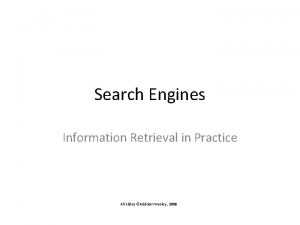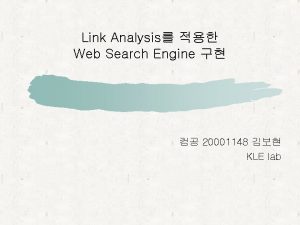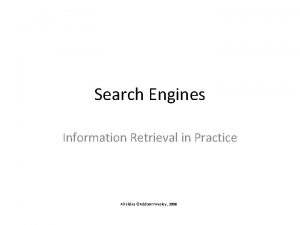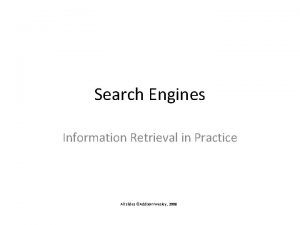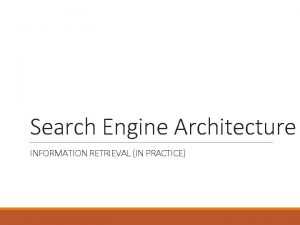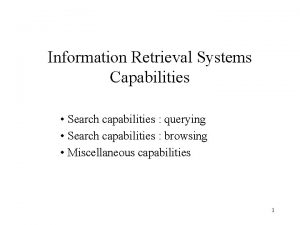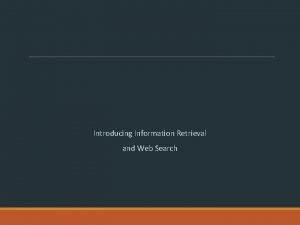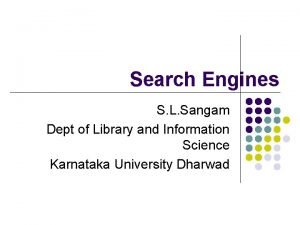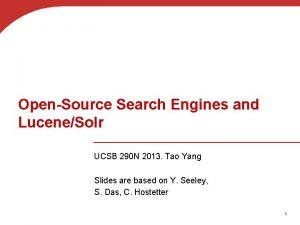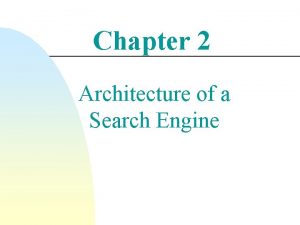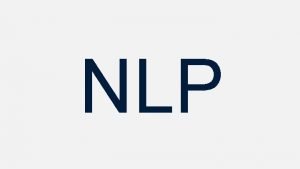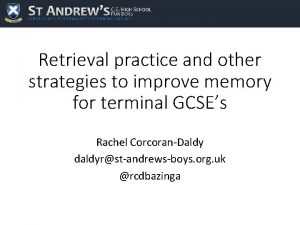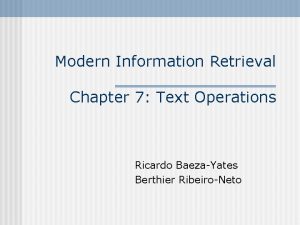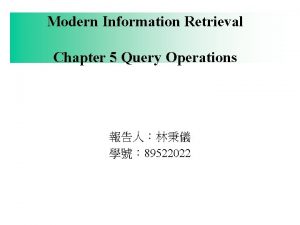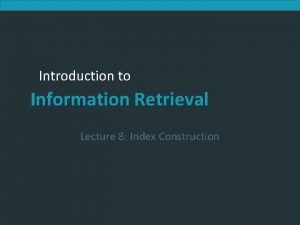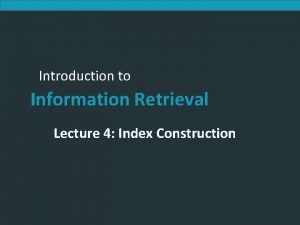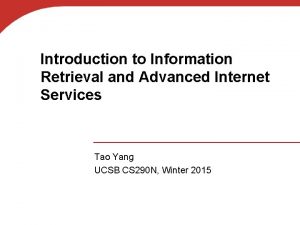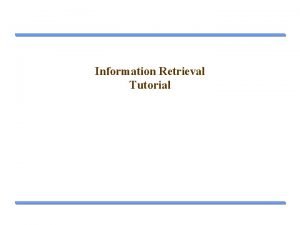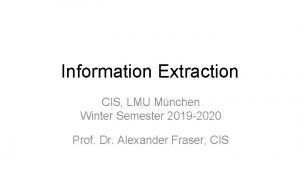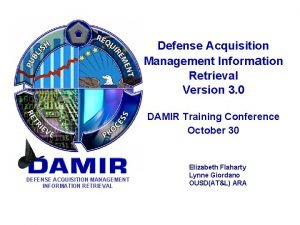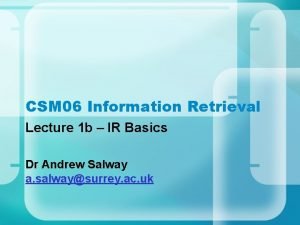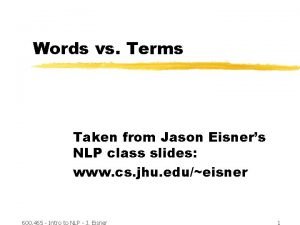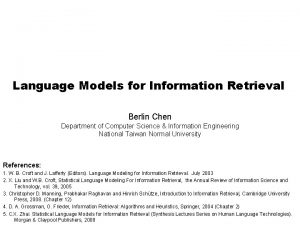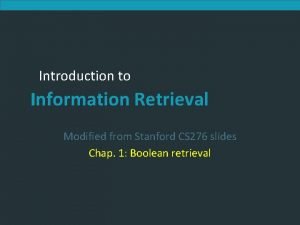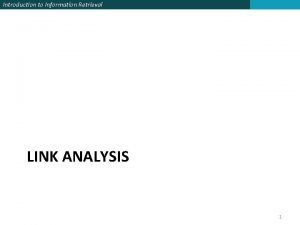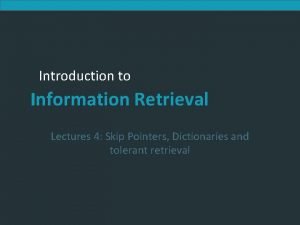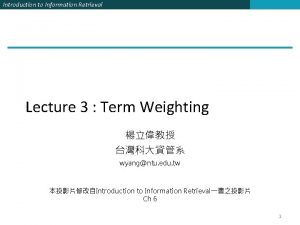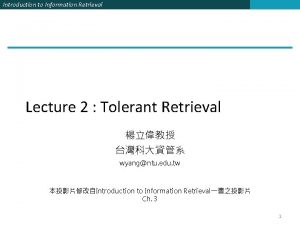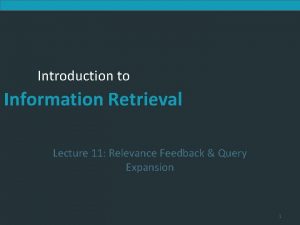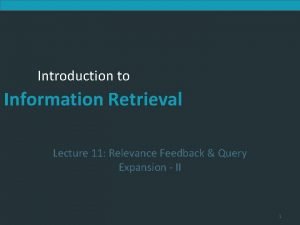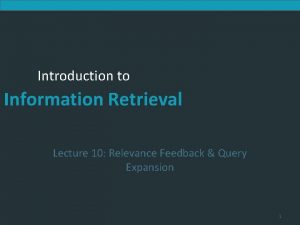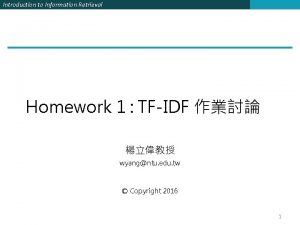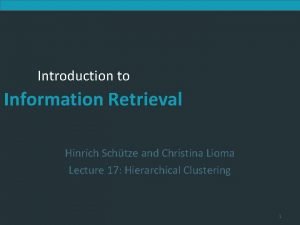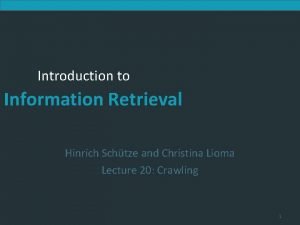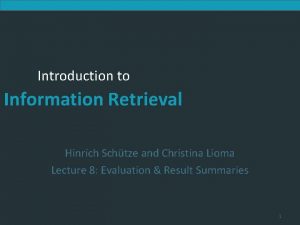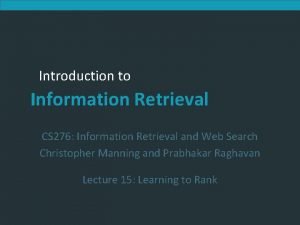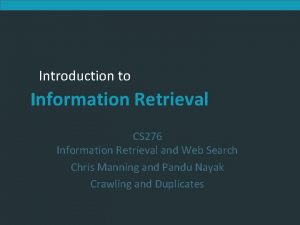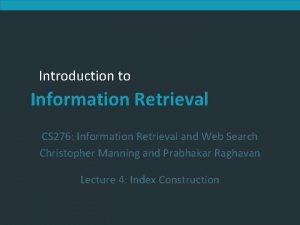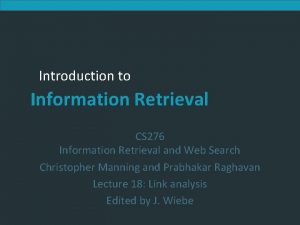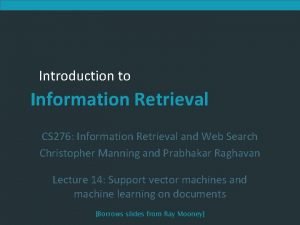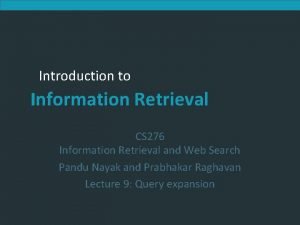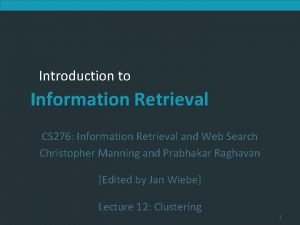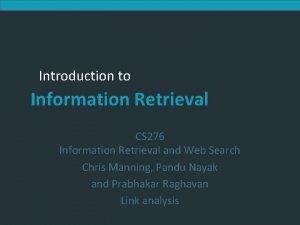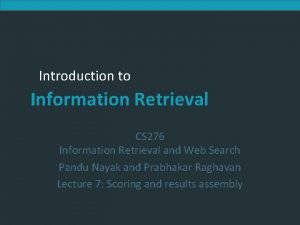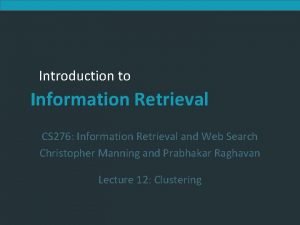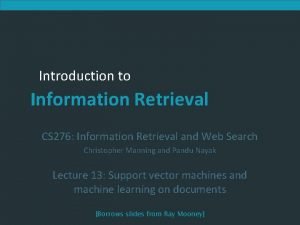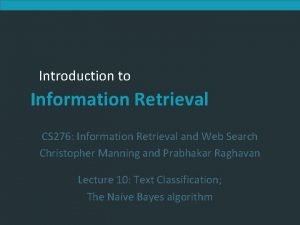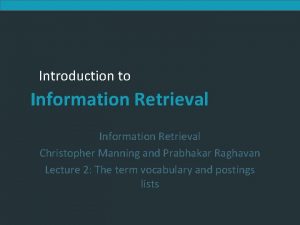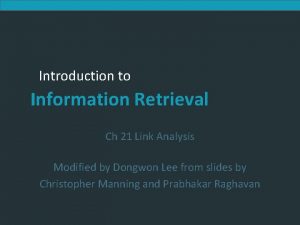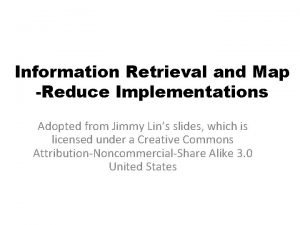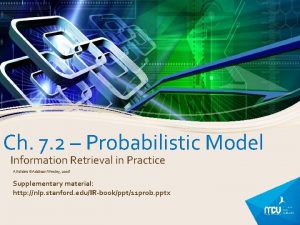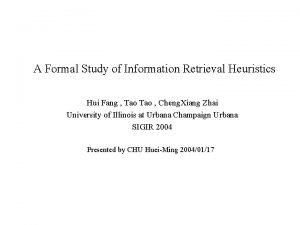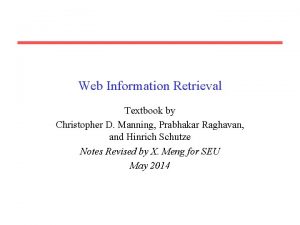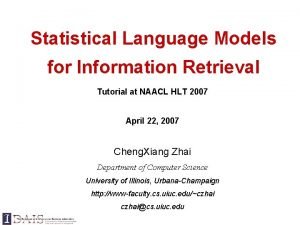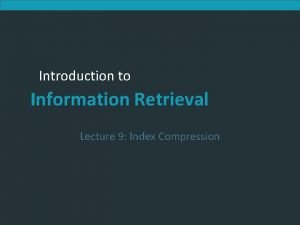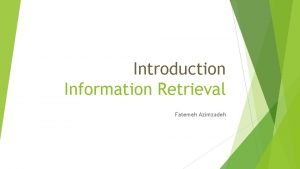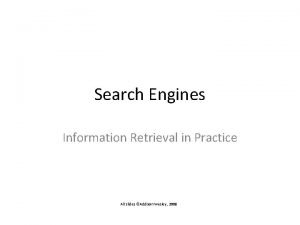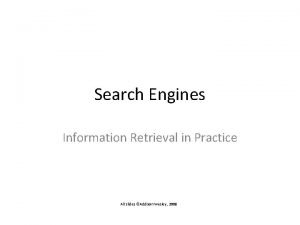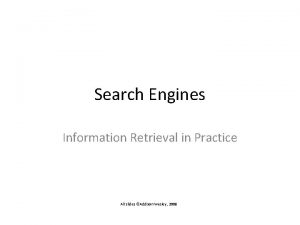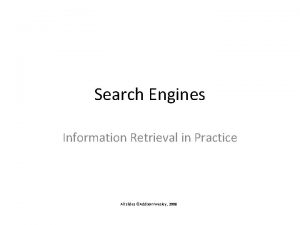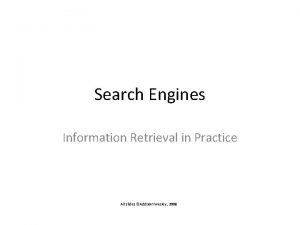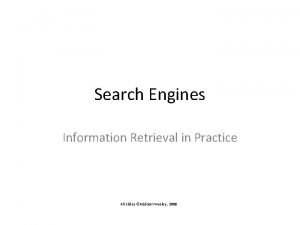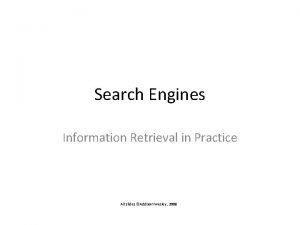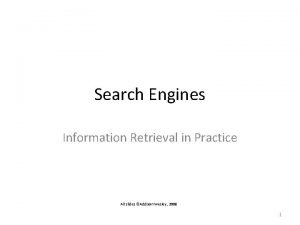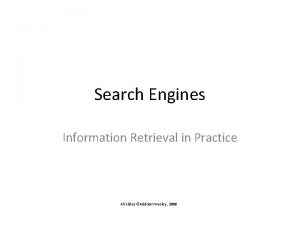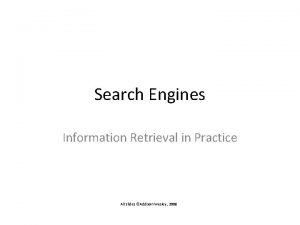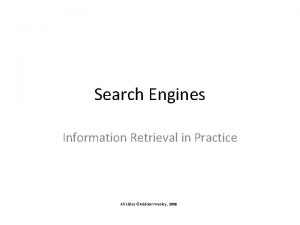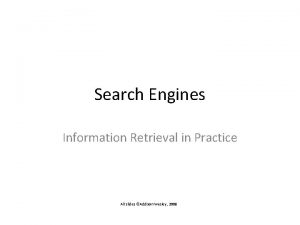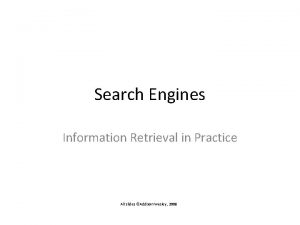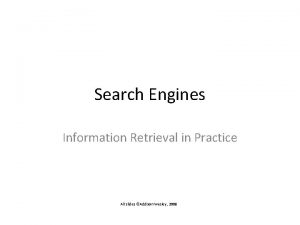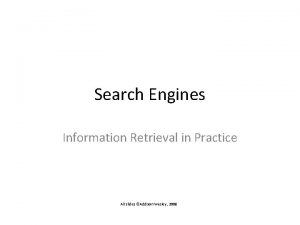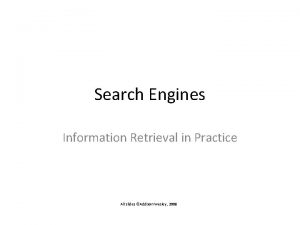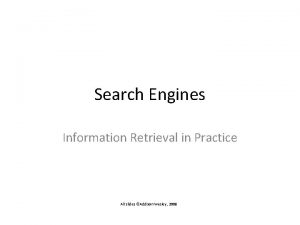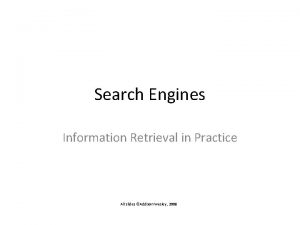Search Engines Information Retrieval in Practice All slides







































































- Slides: 71

Search Engines Information Retrieval in Practice All slides ©Addison Wesley, 2008

Hash Table • Used to built inverted index • Allows for very fast retrieval of data, no mater how much data there is – For example, a linear search is very costly – Lookup time in a hash table (array), assuming you know the index number is independent of the size of the array – Each index number can be calculated using the array value (word, token, etc. ).

Simple Hash Calculation • Take the word Mia • Get the ASCII code for each letter – M=77, i=105, a=97 • Add them together – 279 • Divide by the number of elements in the array and take the remainder – Remainder (279 / 11) = 4

More Hashes • Tim – Remainder (Sum(T=84, i=105, m=109)/11) = 1 – R(298/11) = 1 • Bea – Remainder (Sum(B=66, e=101, a=97)/11) = 0 – R(264/11) = 0


Collisions https: //www. youtube. com/watch? v=Ky. UTuwz_b 7 Q

https: //www. youtube. com/watch? v=Ky. UTuwz_b 7 Q

Open Addressing/Linear Probing https: //www. youtube. com/watch? v=Ky. UTuwz_b 7 Q

Hash function strategies • Make the hash table bigger than you need it. – 70% of buckets used • Load Factor – Total number of items stored/Size of the array • Worst case access time could be quite high with linear probing. – You have added a linear search – With enough hash buckets, this should be minimized

Chaining

Methods of Collision Resolution • Closed Addressing/Chaining – More items in correct bucket – Use a linked list to access the correct item – If load factor is low (few collisions) then Linear Probing may be faster. • Linear Probing – May result in primary clustering (keys bunch together) • Plus 3 rehash, • Quadratic Probing = (failed attempts)^2 • Double hashing

Perfect Hash Function? • • • Know the data in advance Minimize collisions Uniform distribution Easy to calculate Easy to resolve collisions

Hash Table Summary • Used to index large amounts of data • Address of each key calculated using the key itself • Collisions resolved with open or closed addressing • Hashing is widely used in database indexing, compilers, caching, password authentication, etc. • Insertion, deletion, and retrieval occur in constant time in best case scenario

What hash algorithm does Python’s dictionary function use? • Python dictionaries are implemented as hash tables. Hash tables consist of slots, and keys are mapped to the slots via a hashing function. • Hash table implementations must allow for hash collisions i. e. even if two keys have same hash value, the implementation of the table must have a strategy to insert and retrieve the key and value pairs unambiguously. • Python dict uses open addressing to resolve hash collisions (see dictobject. c: 296 -297). • In open addressing, hash collisions are resolved by probing (explained below). • The hash table is just a contiguous block of memory (like an array, so you can do O(1) lookup by index). • Each slot in the hash table can store one and only one entry. This is important. https: //stackoverflow. com/questions/21595048/how-python-dict-storeskey-value-when-collision-occurs

Web Crawler • Finds and downloads web pages automatically – provides the collection for searching • Web is huge and constantly growing • Web is not under the control of search engine providers • Web pages are constantly changing • Crawlers also used for other types of data

Retrieving Web Pages • Every page has a unique uniform resource locator (URL) • Web pages are stored on web servers that use HTTP to exchange information with client software • e. g. ,

Retrieving Web Pages • Web crawler client program connects to a domain name system (DNS) server • DNS server translates the hostname into an internet protocol (IP) address • Crawler then attempts to connect to server host using specific port (e. g. 80) • After connection, crawler sends an HTTP request to the web server to request a page – usually a GET request

Hypertext Transfer Protocol • 1. Client/Server • 2. Stateless – each transaction is independent – But there are sessions and cookies! • 3. Application Layer - over TCP usually • 4. Client Actions – Get, Post, Delete, … • 5. Server Status Codes – response back to client, e. g. 404 Not Found… • 6. Headers – custom info with rqst and rspns, . e. g. Request Type – Content file, Cache Control https: //www. youtube. com/watch? v=Sz. SXHv 8 RKd. M

Crawling the Web

Web Crawler • Starts with a set of seeds, which are a set of URLs given to it as parameters • Seeds are added to a URL request queue • Crawler starts fetching pages from the request queue • Downloaded pages are parsed to find link tags that might contain other useful URLs to fetch • New URLs added to the crawler’s request queue, or frontier • Continue until no more new URLs or disk full

Web Crawling • Web crawlers spend a lot of time waiting for responses to requests • To reduce this inefficiency, web crawlers use threads and fetch hundreds of pages at once • Crawlers could potentially flood sites with requests for pages • To avoid this problem, web crawlers use politeness policies – e. g. , delay between requests to same web server

Controlling Crawling • Even crawling a site slowly will anger some web server administrators, who object to any copying of their data • Robots. txt file tries to control crawlers

Simple Crawler Thread

Freshness • Web pages are constantly being added, deleted, and modified • Web crawler must continually revisit pages it has already crawled to see if they have changed in order to maintain the freshness of the document collection – stale copies no longer reflect the real contents of the web pages

Freshness • HTTP protocol has a special request type called HEAD that makes it easy to check for page changes – returns information about page, not page itself

Freshness • Not possible to constantly check all pages – must check important pages and pages that change frequently • Freshness is the proportion of pages that are fresh • Optimizing for this metric can lead to bad decisions, such as not crawling popular sites • Age is a better metric • See the You. Tube about this by Victor Lavrenko Web crawling 6: Keeping index fresh at https: //www. youtube. com/watch? v=qr. BXI_hr. Wr. I

Freshness vs. Age

Age • Expected age of a page t days after it was last crawled: • Web page updates follow the Poisson distribution on average – time until the next update is governed by an exponential distribution

Age • Older a page gets, the more it costs not to crawl it – e. g. , expected age with mean change frequency λ = 1/7 (one change per week)

Focused Crawling • Attempts to download only those pages that are about a particular topic – used by vertical search applications • Rely on the fact that pages about a topic tend to have links to other pages on the same topic – popular pages for a topic are typically used as seeds • Crawler uses text classifier to decide whether a page is on topic

Deep Web • Sites that are difficult for a crawler to find are collectively referred to as the deep (or hidden) Web – much larger than conventional Web • Three broad categories: – private sites • no incoming links, or may require log in with a valid account – form results • sites that can be reached only after entering some data into a form – scripted pages • pages that use Java. Script, Flash, or another client-side language to generate links

Sitemaps • Sitemaps contain lists of URLs and data about those URLs, such as modification time and modification frequency • Generated by web server administrators • Tells crawler about pages it might not otherwise find • Gives crawler a hint about when to check a page for changes

Sitemap Example

Distributed Crawling • Three reasons to use multiple computers for crawling – Helps to put the crawler closer to the sites it crawls – Reduces the number of sites the crawler has to remember – Reduces computing resources required • Distributed crawler uses a hash function to assign URLs to crawling computers – hash function should be computed on the host part of each URL

Desktop Crawls • Used for desktop search and enterprise search • Differences to web crawling: – Much easier to find the data – Responding quickly to updates is more important – Must be conservative in terms of disk and CPU usage – Many different document formats – Data privacy very important

Document Feeds • Many documents are published – created at a fixed time and rarely updated again – e. g. , news articles, blog posts, press releases, email • Published documents from a single source can be ordered in a sequence called a document feed – new documents found by examining the end of the feed

Document Feeds • Two types: – A push feed alerts the subscriber to new documents – A pull feed requires the subscriber to check periodically for new documents • Most common format for pull feeds is called RSS – Really Simple Syndication, RDF Site Summary, Rich Site Summary, or. . .

RSS Feed • File format for programs to pass data about: – Content type – What’s new • Has ”onscreen” guide of – Channels (website, blog) with descriptions – Programs (items) with descriptions • XML - Looks a lot like HTML – Tags for channel, item, title, description, link • Blogs, Forums, news sites generate RSS feeds https: //www. youtube. com/watch? v=cekm 0 RJCQ 9 A

RSS Example

RSS Example

RSS • ttl tag (time to live) – amount of time (in minutes) contents should be cached • RSS feeds are accessed like web pages – using HTTP GET requests to web servers that host them • Easy for crawlers to parse • Easy to find new information

Conversion • Text is stored in hundreds of incompatible file formats – e. g. , raw text, RTF, HTML, XML, Microsoft Word, ODF, PDF • Other types of files also important – e. g. , Power. Point, Excel • Typically use a conversion tool – converts the document content into a tagged text format such as HTML or XML – retains some of the important formatting information

Character Encoding • A character encoding is a mapping between bits and glyphs – i. e. , getting from bits in a file to characters on a screen – Can be a major source of incompatibility • ASCII is a basic character encoding scheme for English – encodes 128 letters, numbers, special characters, and control characters in 7 bits, extended with an extra bit for storage in bytes

Character Encoding • Other languages can have many more glyphs – e. g. , Chinese has more than 40, 000 characters, with over 3, 000 in common use • Many languages have multiple encoding schemes – e. g. , CJK (Chinese-Japanese-Korean) family of East Asian languages, Hindi, Arabic – must specify encoding – can’t have multiple languages in one file • Unicode developed to address encoding problems

Unicode • Single mapping from numbers to glyphs that attempts to include all glyphs in common use in all known languages • Unicode is a mapping between numbers and glyphs – does not uniquely specify bits to glyph mapping! – e. g. , UTF-8, UTF-16, UTF-32

Unicode • Proliferation of encodings comes from a need for compatibility and to save space – UTF-8 uses one byte for English (ASCII), as many as 4 bytes for some traditional Chinese characters – variable length encoding, more difficult to do string operations – UTF-32 uses 4 bytes for every character • Many applications use UTF-32 for internal text encoding (fast random lookup) and UTF-8 for disk storage (less space)

Unicode – e. g. , Greek letter pi (π) is Unicode symbol number 960 – In binary, 00000011 11000000 (3 C 0 in hexadecimal) – Final encoding is 11001111 10000000 (CF 80 in hexadecimal)

Storing the Documents • Many reasons to store converted document text – saves crawling time when page is not updated – provides efficient access to text for snippet generation, information extraction, etc. • Database systems can provide document storage for some applications – web search engines use customized document storage systems

Storing the Documents • Requirements for document storage system: – Random access • request the content of a document based on its URL • hash function based on URL is typical – Compression and large files • reducing storage requirements and efficient access – Update • handling large volumes of new and modified documents • adding new anchor text

Large Files • Store many documents in large files, rather than each document in a file – avoids overhead in opening and closing files – reduces seek time relative to read time • Compound documents formats – used to store multiple documents in a file – e. g. , TREC Web

TREC Web Format

Compression • Text is highly redundant (or predictable) • Compression techniques exploit this redundancy to make files smaller without losing any of the content • Compression of indexes covered later • Popular algorithms can compress HTML and XML text by 80% – e. g. , DEFLATE (zip, gzip) and LZW (UNIX compress, PDF) – may compress large files in blocks to make access faster

Big. Table • Google’s document storage system – Customized for storing, finding, and updating web pages – Handles large collection sizes using inexpensive computers

Big. Table • No query language, no complex queries to optimize • Only row-level transactions • Tablets are stored in a replicated file system that is accessible by all Big. Table servers • Any changes to a Big. Table tablet are recorded to a transaction log, which is also stored in a shared file system • If any tablet server crashes, another server can immediately read the tablet data and transaction log from the file system and take over

Big. Table • Logically organized into rows • A row stores data for a single web page • Combination of a row key, a column key, and a timestamp point to a single cell in the row

Big. Table • Big. Table can have a huge number of columns per row – all rows have the same column groups – not all rows have the same columns – important for reducing disk reads to access document data • Rows are partitioned into tablets based on their row keys – simplifies determining which server is appropriate

Detecting Duplicates • Duplicate and near-duplicate documents occur in many situations – Copies, versions, plagiarism, spam, mirror sites – 30% of the web pages in a large crawl are exact or near duplicates of pages in the other 70% • Duplicates consume significant resources during crawling, indexing, and search – Little value to most users

Duplicate Detection • Exact duplicate detection is relatively easy • Checksum techniques – A checksum is a value that is computed based on the content of the document • e. g. , sum of the bytes in the document file – Possible for files with different text to have same checksum • Functions such as a cyclic redundancy check (CRC), have been developed that consider the positions of the bytes

Near-Duplicate Detection • More challenging task – Are web pages with same text context but different advertising or format near-duplicates? • A near-duplicate document is defined using a threshold value for some similarity measure between pairs of documents – e. g. , document D 1 is a near-duplicate of document D 2 if more than 90% of the words in the documents are the same

Near-Duplicate Detection • Search: – find near-duplicates of a document D – O(N) comparisons required • Discovery: – find all pairs of near-duplicate documents in the collection – O(N 2) comparisons • IR techniques are effective for search scenario • For discovery, other techniques used to generate compact representations

Fingerprints

Fingerprint Example

Simhash • Similarity comparisons using word-based representations more effective at finding nearduplicates – Problem is efficiency • Simhash combines the advantages of the wordbased similarity measures with the efficiency of fingerprints based on hashing • Similarity of two pages as measured by the cosine correlation measure is proportional to the number of bits that are the same in the simhash fingerprints

Simhash

See notes

Simhash Example

Removing Noise • Many web pages contain text, links, and pictures that are not directly related to the main content of the page • This additional material is mostly noise that could negatively affect the ranking of the page • Techniques have been developed to detect the content blocks in a web page – Non-content material is either ignored or reduced in importance in the indexing process

Noise Example

Finding Content Blocks • Cumulative distribution of tags in the example web page – Main text content of the page corresponds to the “plateau” in the middle of the distribution

Finding Content Blocks • Represent a web page as a sequence of bits, where bn = 1 indicates that the nth token is a tag • Optimization problem where we find values of i and j to maximize both the number of tags below i and above j and the number of nontag tokens between i and j • i. e. , maximize

Finding Content Blocks • Other approaches use DOM structure and visual (layout) features
 Information retrieval slides
Information retrieval slides Search engines information retrieval in practice
Search engines information retrieval in practice Search engines information retrieval in practice
Search engines information retrieval in practice Search engines information retrieval in practice
Search engines information retrieval in practice Search engine architecture
Search engine architecture Search capabilities in information retrieval system
Search capabilities in information retrieval system Information retrieval and web search
Information retrieval and web search Meta search engines
Meta search engines Search engines
Search engines Meta search engines compared
Meta search engines compared Open source search engines
Open source search engines Architecture of a search engine
Architecture of a search engine Other search engines
Other search engines Dot search
Dot search Www.sbu
Www.sbu A small child slides down the four frictionless slides
A small child slides down the four frictionless slides Energy of four forces quick check
Energy of four forces quick check Retrieval practice cpd
Retrieval practice cpd Retrieval practice
Retrieval practice What is sequential search
What is sequential search Precision and recall in information retrieval
Precision and recall in information retrieval Text operations in information retrieval
Text operations in information retrieval Query operations in information retrieval
Query operations in information retrieval Skip pointer information retrieval
Skip pointer information retrieval Index construction in information retrieval
Index construction in information retrieval Spimi
Spimi Which internet service is used for information retrieval
Which internet service is used for information retrieval Information retrieval tutorial
Information retrieval tutorial Wildcard queries in information retrieval
Wildcard queries in information retrieval Link analysis in information retrieval
Link analysis in information retrieval Information retrieval lmu
Information retrieval lmu Defense acquisition management information retrieval
Defense acquisition management information retrieval Advantages of information retrieval system
Advantages of information retrieval system Information retrieval nlp
Information retrieval nlp Information retrieval data structures and algorithms
Information retrieval data structures and algorithms Relevance information retrieval
Relevance information retrieval Stanford information retrieval
Stanford information retrieval Link analysis in information retrieval
Link analysis in information retrieval Skip pointers in information retrieval
Skip pointers in information retrieval Log frequency weighting
Log frequency weighting Levenshtein distance for oslo-snow
Levenshtein distance for oslo-snow Information retrieval
Information retrieval Information retrieval
Information retrieval Relevance information retrieval
Relevance information retrieval Information retrieval
Information retrieval Information retrieval
Information retrieval Information retrieval
Information retrieval Information retrieval
Information retrieval Cs-276
Cs-276 Information retrieval
Information retrieval Cs 276
Cs 276 Information retrieval
Information retrieval Information retrieval
Information retrieval Relevance information retrieval
Relevance information retrieval Information retrieval
Information retrieval Information retrieval
Information retrieval Information retrieval
Information retrieval Information retrieval
Information retrieval Information retrieval
Information retrieval Information retrieval
Information retrieval Tokenization in information retrieval
Tokenization in information retrieval Link analysis in information retrieval
Link analysis in information retrieval Map information retrieval
Map information retrieval Information retrieval data structures and algorithms
Information retrieval data structures and algorithms Probabilistic model information retrieval
Probabilistic model information retrieval A formal study of information retrieval heuristics
A formal study of information retrieval heuristics Relevance information retrieval
Relevance information retrieval Information retrieval textbook
Information retrieval textbook Statistical language models for information retrieval
Statistical language models for information retrieval Trevor strohman
Trevor strohman Index compression in information retrieval
Index compression in information retrieval Introduction to information retrieval
Introduction to information retrieval
